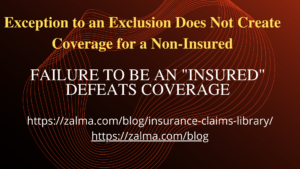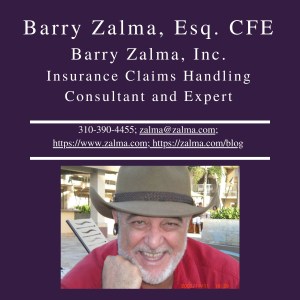Exception to an Exclusion Does Not Create Coverage for a Non-Insured


While driving her Honda CRV in Clark County, Nevada, Brittney Gardineer was involved in an accident with a Ford Explorer driven by Lynette Hill, who is now known as Landon Hill (“Hill”). The Ford Explorer was owned by Hill’s father-in-law, Dennis Hill (“Dennis”), and Hill was driving it with his permission. In American National Property and Casualty Company v. Brittney L. Gardineer, No. 20-15826, United States Court of Appeals, Ninth Circuit (February 11, 2022) the Ninth Circuit was asked to determine if an exception to an exclusion created coverage for a permissive driver of an insured’s car.
FACTS
In August 2015, Gardineer filed suit in Nevada state court against Hill and Dennis for damages arising from the accident. Although Dennis had not been driving the Explorer, he was sued on a theory of negligent entrustment. At the time of the accident, Dennis had both a primary automobile insurance policy and an umbrella policy with American National Property and Casualty Company (“ANPAC”).
In exchange for dismissal with prejudice of the lawsuit against Hill and Dennis’s Estate, ANPAC agreed to pay to Gardineer the policy limit ($250,000) of Dennis’s automobile insurance policy. Under the terms of the settlement, however, Gardineer expressly reserved the right to assert that ANPAC had a “duty to indemnify” Hill, under Dennis’s umbrella policy, for Hill’s liability arising from the accident.
If ANPAC succeeded in defeating coverage for Hill’s liability under the umbrella policy, then Gardineer would receive nothing further. If Gardineer established coverage, then the parties would determine the additional damages that Gardineer should receive.
DISCUSSION
After conducting discovery, ANPAC and Gardineer filed cross-motions for summary judgment in 2019. The district court held that ANPAC had no duty to indemnify Hill under Dennis’s umbrella policy, and the court therefore granted ANPAC’s motion for summary judgment and denied Gardineer’s.
Under Nevada law, the threshold question in construing an insurance policy is whether the relevant language of the policy is ambiguous or unambiguous. As with all questions of insurance-policy construction, the court must consider the relevant language in the context of the “policy as a whole” and should avoid any interpretation that would “lead to an absurd or unreasonable result.”
Notably, in describing the coverage granted, the first two sentences each use the identical phrase “damages for which an insured becomes legally liable” (emphasis added), which each sentence then combines with certain respective additional limitations. Accordingly, by its plain terms, this coverage section only provides coverage for certain damages for which an “insured” becomes liable. This section therefore extends coverage to Hill’s liability for damages only if Hill is an “insured” within the meaning of the policy.
Since the only named insured listed in the policy’s “Declarations” is Dennis, and he had a wife who lived in the same household with him. Accordingly, the term “insured” under the policy means Dennis, his wife, and any “relative.” In turn, the policy defines a “relative” as “a person living in your household and related to you by blood, marriage, or adoption, including a ward or foster child.” Because it is undisputed that Hill did not reside in Dennis and his wife’s household, Hill does not qualify as a “relative” under the policy and is therefore not an “insured” under the policy. Because Hill is not an “insured,” the unambiguous language of the coverage section of Dennis’s umbrella policy does not extend coverage to Hill’s liability arising from the accident with Gardineer.
Gardineer’s argument relied on the following express exclusion (“Exclusion 29”) contained within the policy:
We do not provide coverage for:
. . .
any loss arising out of the entrustment by any insured to any person with regard to the ownership, maintenance, use, loading, or unloading of any vehicle or aircraft.
This exclusion does not apply if coverage is provided by primary insurance described in the Declarations. Our coverage is no broader than the primary insurance, except for our limit of liability.
Gardineer argues that, by expressly stating that the exclusion’s denial of coverage “does not apply if” (as here) “coverage is provided by primary insurance” (emphasis added), Exclusion 29 can be read to say that such “primary insurance” provides the benchmark for determining the umbrella policy’s coverage-subject only to the modification (noted in the next sentence) that the umbrella policy’s higher “limit of liability” applies.
Exclusion 29 states that certain losses are not covered by the umbrella policy, even if they would otherwise fall within the terms of that policy’s coverage clause. However, Exclusion 29 then states that the “exclusion” it sets forth “does not apply” if relevant “coverage” is provided by “primary insurance described in the Declarations.” Here, there is no dispute that relevant “coverage is provided by primary insurance described in the Declarations” and that the exception to Exclusion 29 therefore applies. Even if the exclusion is thus inoperative, Gardineer contends that “‘coverage is revived‘” or “re-establish[ed]” in accordance with the otherwise applicable coverage terms of the umbrella policy.
However, because Hill’s liability is not covered by the language of the umbrella policy’s coverage section, she is not an insured, the removal of the particular exclusion set forth in Exclusion 29 makes no difference vis-à-vis her liability.
Because triggering the exception renders Exclusion 29 inoperative, its effect is necessarily to leave in place whatever coverage would have existed in the absence of Exclusion 29. That is, because Exclusion 29 categorically bars coverage of the excluded losses-without regard to whether they otherwise would or would not have been covered-removing that bar does not, as Gardineer would have it, create a converse categorical rule granting coverage to all such claims. It simply removes that categorical bar, thereby leaving coverage to be described elsewhere in the policy. Here, that means the coverage section of the umbrella policy and, as explained earlier, that coverage does not extend to Hill’s liability.
Accordingly, the Ninth Circuit rejected Gardineer’s argument that Exclusion 29 creates an ambiguity as to whether Hill’s liability is covered under Dennis’s umbrella policy. Under its reading of the plain language of that policy, Exclusion 29’s exception does not expand the policy’s coverage beyond its underlying coverage terms.
Dennis’s umbrella policy does not require ANPAC to indemnify Hill for her liability from the accident with Gardineer since she was not an “insured” and not covered by the basic insuring agreement of the umbrella policy that, by its plain and unambiguous terms, did not provide coverage for Lynette Hill’s liability arising from her use of Dennis’s vehicle. The district court, therefore, correctly granted summary judgment to ANPAC.
The Ninth Circuit read the entire policy and reached the only proper and reasonable decision: a person needs to fit within the definition of “insured” to be able to obtain defense or indemnity from an insurance policy. Since Hill was not an insured of the umbrella policy she had no right to indemnity from that policy regardless of the creative arguments concerning an exclusion that contained an exception that eliminated the effect of an exclusion. For an exclusion or an exception to an exclusion to have an effect on a person’s rights that person must qualify as an “insured.” Hill did not. The Ninth Circuit’s opinion could have stopped at the point it determined Hill was not an insured.

© 2022 – Barry Zalma
Barry Zalma, Esq., CFE, now limits his practice to service as an insurance consultant specializing in insurance coverage, insurance claims handling, insurance bad faith and insurance fraud almost equally for insurers and policyholders.
He practiced law in California for more than 44 years as an insurance coverage and claims handling lawyer and more than 54 years in the insurance business.
Subscribe to “Zalma on Insurance” at https://zalmaoninsurance.locals.com/subscribe and “Excellence in Claims Handling” at https://barryzalma.substack.com/welcome.
You can contact Mr. Zalma at https://www.zalma.com, https://www.claimschool.com, zalma@claimschool.com and zalma@zalma.com . Mr. Zalma is the first recipient of the first annual Claims Magazine/ACE Legend Award.
You may find interesting the podcast “Zalma On Insurance” at https://anchor.fm/barry-zalma; you can follow Mr. Zalma on Twitter at; you should see Barry Zalma’s videos on https://www.youtube.com/channel/UCysiZklEtxZsSF9DfC0Expg/featured; or videos on https://rumble.com/zalma. Go to the Insurance Claims Library – https://zalma.com/blog/insurance-claims–library/ The last two issues of ZIFL are available at https://zalma.com/zalmas-insurance-fraud-letter-2/
Like this:
Loading…







